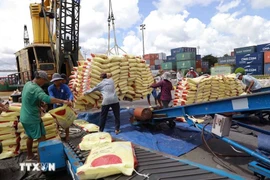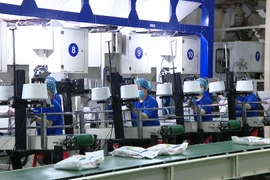Hanoi (VNS/VNA) - Although rice prices remain steady due to abundant supply, experts anticipate a market rebound in the near future.
Do Ha Nam, Vice Chairman of the Vietnam Food Association (VFA), said that customer demand remains high, with Vietnam exporting over 1 million tonnes of rice in the first two months of the year.
He said that the ongoing winter-spring harvest yields the highest-quality rice of the year, making it a crucial buying period for importers. Countries with significant import needs are expected to resume trading soon, as missing this season could lead to difficulties in securing adequate supplies later.
V. Subramanian, co-founder of SSricenews - a specialised rice market platform - echoed this outlook. Speaking at a recent conference in Ho Chi Minh City, he pointed to increasing demand from Malaysia, China and Africa, where buyers are ramping up purchases. This trend suggests a potential trade boom in the coming months.
Minister of Agriculture and Environment Do Duc Duy said that the current market situation was an adjustment phase, which experts consider a normal fluctuation for commodities, including rice.
Despite this, the Government remained vigilant, closely monitoring market developments and implementing policies to stabilise supply and demand both at home and abroad.
The Vietnamese rice industry would maintain its export target of approximately 7.8 million tonnes this year, while ensuring competitive pricing in the high-quality rice segment to secure strong profits for businesses and farmers.
To achieve these goals, Duy urged businesses to continue expanding their presence in the global rice market. Alongside traditional markets, he emphasised the importance of tapping into new, high-potential regions such as the US, the EU, the Middle East, and Africa.
He called on businesses to comply with rice export regulations while increasing production capacity. Strengthening links between purchasing enterprises, farmers, and exporters would be key to improving the production chain and ensuring market stability.
The minister also urged experienced businesses with established customer networks to invest in expanding warehouse infrastructure and logistics systems.
By increasing temporary rice purchases during market adjustments, businesses could secure a steady supply for export. This strategy, he said, would help enterprises maximise profitability.
Duy also called on businesses involved in rice production and export to strengthen cooperation, share expertise, and support market expansion to ensure supply meets demand at optimal times.
He said that his ministry would continue advising the Government and relevant agencies on policies to ensure a stable, balanced, and professional rice market.
Additionally, priority and incentives would be given to businesses that operate systematically, comply with regulations, and establish strong links across the production, purchasing, processing, and export chain.
Meanwhile, Bui Trung Thuong, Vietnamese Trade Counsellor in India, said that the current rice price range of 390-420 USD per tonne - down from a peak of 700 USD per tonne - was reasonable and would benefit both exporters and importers.
He said that global rice prices were expected to remain stable due to several key factors, including a projected 10-million-tonne increase in global production this year, the expanded use of rice in ethanol production and industrial applications, and steady demand, with nearly 50% of the world’s population relying on rice as a staple food.
Given this context, Thuong urged Vietnamese rice exporters to strengthen their global competitiveness and diversify markets and sales channels.
He also advised firms to focus on developing high-quality rice varieties and building geographical indication-based branding to enhance their global reputation.
Additionally, he recommended that businesses reduce reliance on government-to-government deals and expand into the private sector while maintaining their market share, even in regions with lower export volumes or turnover, to ensure long-term stability./.

See more
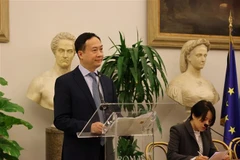
Vietnam - bright spot in Italy's Asia strategy
Vietnam is currently Italy's largest trading partner in ASEAN, with bilateral trade turnover reaching 6.9 billion USD in 2024, an increase of 13.1% year-on-year.
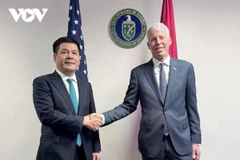
Vietnam, US look to strengthen comprehensive energy cooperation
Vietnam’s consistent policy is to foster a balanced, sustainable, stable, and win-win economic relationship with the US, the minister stated. Vietnam does not intend to create any barriers that could negatively impact the US’s workers or its economic and national security, Minister of Industry and Trade Nguyen Hong Dien said.

Private sector's development key to Vietnam’s economic growth
Currently, the private economic sector comprises over 6.1 million business establishments, including approximately 940,000 registered enterprises and over 5.2 million household businesses. The sector contributes around 50% of the country’s GDP, accounts for over 56% of total social investment, employs approximately 82% of the workforce, and generates around 30% of state budget revenue and more than 30% of total import-export turnover.

Video shopping set to become next major trend in e-commerce
Video shopping is emerging as a new trend, compelling sellers to adopt multi-channel strategies while enhancing key services such as express delivery, after-sales support and exclusive promotions.
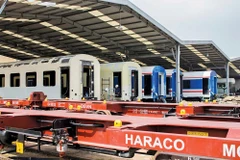
Vietnam’s railway industry gears up for major boost
Vietnam’s railway industry can draw valuable lessons from countries that have successfully developed their domestic railway sectors.

Sugar products from Indonesian company subject to anti-circumvention measures
An investigation by the Ministry of Industry and Trade shows that PT. Kebun Tebu Mas has circumvented Vietnam’s trade defence measures for certain sugar products.
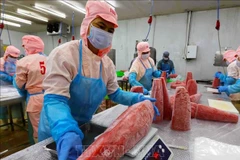
Vietnam’s tuna exports face new challenges
One of the major factors impacting export trends is the limited supply of raw materials, particularly those caught by domestic fishing fleets.
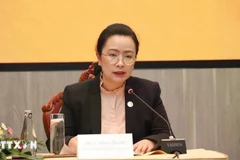
Vietnam, Laos promote payments in local currencies to boost trade
Expanding local currency usage will offer businesses greater flexibility in payment options, lowering transaction costs and easing foreign currency demand pressures.
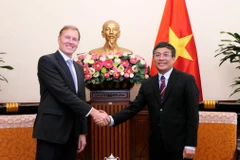
Vietnam urges Airbus to expand collaboration in high-tech industries, human resource training
Permanent Deputy Minister of Foreign Affairs Nguyen Minh Vu on March 14 suggested Airbus expand its cooperation with Vietnam, especially in high-tech industries and human resource training.
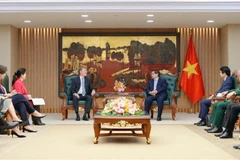
PM suggests Airbus help Vietnam in developing aviation ecosystem
During a meeting on March 14 with Wouter Van Wersch, Executive Vice President International of Airbus, Prime Minister Pham Minh Chinh praised the aerospace giant’s cooperation with Vietnamese partners, emphasising its role in boosting domestic and international connectivity and driving Vietnam’s socio-economic growth.
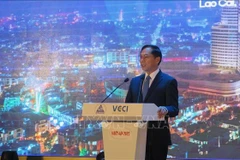
Lao Cai aims to become trade hub bridging Vietnam, ASEAN with southwest China
Lao Cai serves as a crucial point within the Southern Corridor of the Belt and Road Initiative (BRI) and the economic corridor linking Yunnan with Vietnam's Quang Ninh, Hai Phong, Hanoi and Lao Cai.
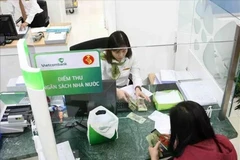
State budget revenue surges, nears 30% of annual target
Central budget revenue stood at 28.04% of the target, while local budget revenue hit 30.46%.
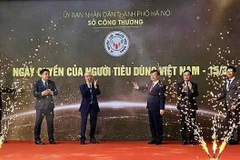
Hanoi launches campaign for Consumer Rights Day
The event, organised by the city's Department of Industry and Trade, aimed to promote consumer protection as a long-term, essential task for all levels of government, businesses and society.

Thailand's largest meat producer to launch IPO in Vietnam
CPF CEO Prasit Boondoungprasert told media that the company would begin the IPO process as soon as it received approval from Vietnamese authorities.
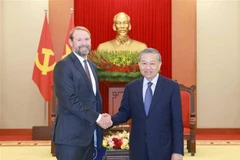
Party chief calls for more investments from Pacifico Energy
Party General Secretary To Lam praised PE’s contributions to Vietnam’s renewable energy sector and the broader Vietnam-US partnership.
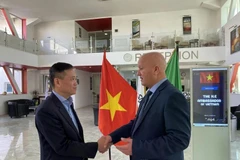
Vietnam’s oil venture in Algeria advances to second phase with promising results
PVEP aims to deepen ties with its partners to speed up new contract packages and tap new wells in the second phase, targeting higher output. The company also plans to pursue new deals in promising Algerian blocks to expand its footprint in the North African nation.
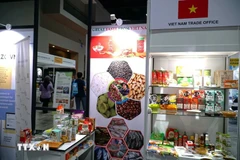
Food to be exported to Malaysia must be certified
Food imported to Malaysia must be produced in facilities that follow food safety assurance programmes recognised by the Malaysian Ministry of Health.
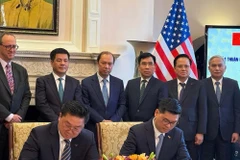
Vietnam – US economic ties strengthened with multiple agreements
PetroVietnam Gas Joint Stock Corporation (PetroVietnam PV Gas) signed Memoranda of Understanding with ConocoPhillips, an independent exploration and production company, and Excelerate Energy regarding long-term liquefied natural gas (LNG) purchase agreements.

Buon Ma Thuot Coffee Festival wraps up
This year’s festival, themed “Buon Ma Thuot – Coffee City,” featured 17 official activities alongside various supporting events across the province. Notably, the festival coincided with the 50th anniversary of Buon Ma Thuot’s victory and the liberation of Dak Lak province (March 10, 1975 – 2025). The event attracted around 250,000 visitors, including 1,800 international guests, leaving a lasting impression with its vibrant cultural programmes rich in traditional identity.

Vietnam, US strengthen economic, trade partnership
Vietnam’s consistent policy is to build harmonious, sustainable, stable, and mutually-beneficial economic and trade ties with the US, he stated, adding that Vietnam has no intention to create any barriers that could harm the US’s workers or economic and national security.
